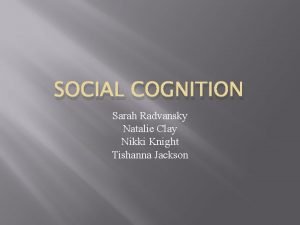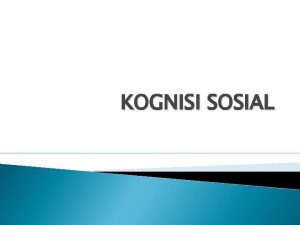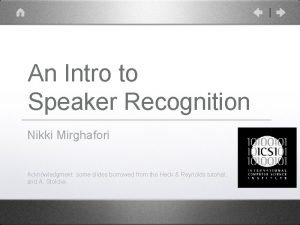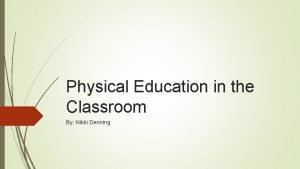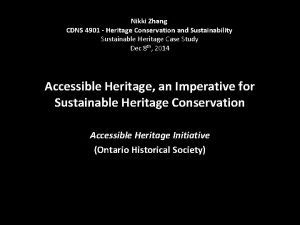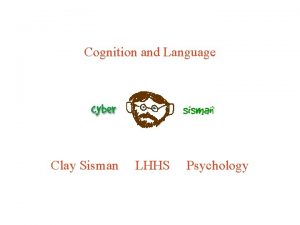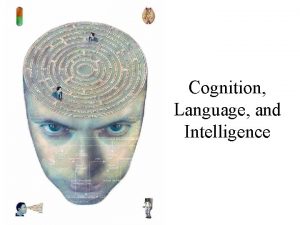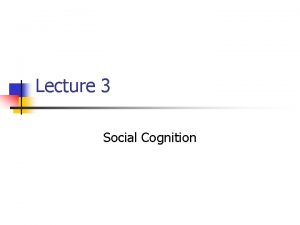SOCIAL COGNITION Sarah Radvansky Natalie Clay Nikki Knight














- Slides: 14

SOCIAL COGNITION Sarah Radvansky Natalie Clay Nikki Knight Tishanna Jackson

History 1941 Millard & Dollard 1963 Bandura & Walters 1977 Bandura (Self-Efficacy) According to Bandura: Social Cognitive Theory explains how people acquire and maintain certain behavioral patterns, while also providing the basis for intervention strategies

Our take on social cognition… It is a process which involves our: perception→belief→attitude→emotion→behavior Our behavior is a function of our perceptions. How we perceive things is based on: Environmental factors Personal characteristics Behavioral patterns.

Attitudes & beliefs form into systems and selfperpetuate, even in the face of contradictory evidence

Environmental Factors Refers to an individual’s social and physical environment. These two particular environments include things such as the nature of a task, punishing and reinforcing. Social Environmental factors include: family members, friends, colleagues. Physical Environmental factors include: size of a classroom, room temperature, Number of students, and availability of certain foods.

Incentive Motivations and Facilitation Incentive motivations are when someone uses rewards and or punishments to help modify a child’s behavior. Facilitation is when and individual uses tools and other environmental resources to help modify a child’s behavior. http: //www. youtube. com/watch? v=c 3 Jo. QAf. Cm. MM&feat ure=related

Examples: Incentive behaviors would include : rewarding a child for good behavior or correct answers while a punishment may be to have time out or being separated from another child. Both of these tactics help teachers to better the behavior of students in the classroom. Facilitation would include : changing the room temperature to a more comfortable level for learning, taking the time to show students a wheelchair ramp and expanding on diversity changing the seating arrangement

Behavioral Pattern Include self-observation, self-evaluation, making changes in behavior to overcome or reduce perceptions, and creating productive study environments. Observational learning/modeling-The part of the triadic reciprocal causation model of social cognitive theory that describes the role of observing and imitating the behavior of models in learning new capabilities. “Monkey see, Monkey do. ” There at least three principles influence modeling: (1) People are most likely to model high-status people (2) People who lack skill or status are most likely to model (3) People tend to model behavior that they see as being rewarding

Bandura recognized four processes of observational learning: (1) Attention, or noticing what a model does (2) Representation, or symbolically representing new response patterns in memory (3) Behavior production, or producing the behavior that one observes (4) Motivation; that is, the observer must be motivated to perform the observed behavior. Ex. Observational Learning: Danny http: //www. youtube. com/watch? v=A 2 w. YLo 0 n. ET 4 Children see, Children do- http: //www. youtube. com/watch? v=7 d 4 gmdl 3 z. NQ&feature=related

Continued… The P<> B of reciprocal causation reveals the interaction between thought, affect and actions. Our expectations, beliefs, selfperceptions and goals shape and direct our behavior. Most parts of environmental factors are not influences until they are triggered by a behavior. The aspect of the potential environment that becomes the actual environment for given individuals depends on how they behave. Example • Commit a crime, you go to jail. • Do well at work, may get a raise and increasing ability to better your circumstances

Personal Characteristics • • Includes mental and emotional factors, metacognitive knowledge and self-efficacy. The cognitive factors include: memory anticipation planning judging. Self-efficacy is the individual judgment of our own capability to perform a specific action. Perceived coping self-efficacy regulates avoidance behavior as well as arousal. The stronger the sense of self-efficacy the bolder people are in taking on threatening activities. EX: Personal characteristics include one’s physical ability such as being able to hold scissors. If someone were unable to hold scissors correctly then they would not be able to learn to cut paper.

Example: When faced with obstacles and failures people who harbor selfdoubts about their capabilities slacken their efforts or give up quickly. Those who have strong beliefs in their capabilities exert greater effort when they fail to master the challenge. EX: The Little Engine That Could by Watty Piper The engine went from I think I can to I know I can to I can

Personal characteristics<> Behavioral patterns - This reflects the interaction between thought, affect, and action. Expectations, beliefs, self-perceptions, goals and intentions give shape and direction to behavior. - What people think, believe, and feel affects how they behave. Environmental factors<> Personal characteristics - This reflects on human expectations, beliefs, emotional bents and cognitive competencies are developed and modified by social influences that convey information and activate reactions through modeling, instruction, and social persuasion.

REFERENCES: http: //www. utwente. nl/cw/theorieenoverzicht/Theory%20 clusters/Health% 20 Communication/Social_cognitive_theory. doc/ http: //www. theglaringfacts. com/social-cognitive-theory-bandura/ http: //www. associatedcontent. com/article/687987/social_cognitive_learnin g_theory. html? cat=72 http: //des. emory. edu/mfp/Bandura 1989 ACD. pdf http: //www. youtube. com/watch? v=5 Nb. TU 1 Eiv. Js http: //www. youtube. com/watch? v=yxd. DDs 8 F 78 c&feature=related http: //www. youtube. com/watch? v=Cu. PNm. Ko. BGMA&feature=related http: //www. youtube. com/watch? v=BWo 7 F 5 zc. Ob. M&feature=related Pajares, F. (2004). Albert Bandura: Biographical sketch. Retrieved month day, year, from http: //des. emory. edu/mfp/bandurabio. html
